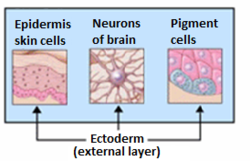Germ layer: Difference between revisions
→Neural crest: ref |
|||
| Line 48: | Line 48: | ||
===Neural crest=== |
===Neural crest=== |
||
Because of its great importance, the [[neural crest]] is sometimes considered a fourth germ layer. It is, however, derived from the ectoderm. |
Because of its great importance, the [[neural crest]] is sometimes considered a fourth germ layer.<ref>Hall BK (2000) The neural crest as a fourth germ layer and vertebrates as quadroblastic not triploblastic. Evolution & Development 2, 3-5.</ref> It is, however, derived from the ectoderm. |
||
== Notes == |
== Notes == |
||
Revision as of 16:50, 20 February 2010
A germ layer, occasionally[1] referred to as a germinal epithelium, is a group of cells, formed during animal embryogenesis. Germ layers are particularly pronounced in the vertebrates; however, all animals more complex than sponges (eumetazoans and agnotozoans) produce two or three primary tissue layers (sometimes called primary germ layers). Animals with radial symmetry, like cnidarians, produce two germ layers (the ectoderm and endoderm) making them diploblastic. Animals with bilateral symmetry produce a third layer between these two layers (appropriately called the mesoderm) making them triploblastic. Germ layers eventually give rise to all of an animal’s tissues and organs through the process of organogenesis.
Germ layers

Caspar Friedrich Wolff observed organization of the early embryo in leaf-like layers. Later, Heinz Christian Pander discovered germ layers while studying chick embryos.
Among animals, sponges show the simplest organization, having a single germ layer. Although they have differentiated cells (e.g. collar cells), they lack true tissue coordination. Diploblastic animals, Cnidaria and Ctenophora, show an increase in complexity, having two germ layers, the endoderm and ectoderm. Diploblastic animals are organized into recognisable tissues. All higher animals (from flatworms to humans) are triploblastic, possessing a mesoderm in additition to the germ layers found in Diploblasts. Triploblastic animals develop recognisable organs.
Development
Fertilization leads to the formation of a zygote. During the next stage, cleavage, mitotic cell divisions transform the zygote into a tiny ball of cells, a blastula. This early embryonic form undergoes gastrulation, forming a gastrula with either two or three layers (the germ layers). In all vertebrates, these are the forerunners of all adult tissues and organs.
The appearance of the archenteron marks the onset of gastrulation.
In humans, after about three days, the zygote forms a solid mass of cells by mitotic division, called a morula. This then changes to a blastocyst, consisting of an outer layer called a trophoblast, and an inner cell mass called the embryoblast. Filled with uterine fluid, the blastocyst breaks out of the zona pellucida and undergoes implantation. The inner cell mass initially has two layers: the hypoblast and epiblast. At the end of the second week, a primitive streak appears. The epiblast in this region moves towards the primitive streak, dives down into it, and forms a new layer, called the endoderm, pushing the hypoblast out of the way (this goes on to form the amnion.) The epiblast keeps moving and forms a second layer, the mesoderm. The top layer is now called the ectoderm.
Endoderm

The endoderm is one of the germ layers formed during animal embryogenesis. Cells migrating inward along the archenteron form the inner layer of the gastrula, which develops into the endoderm.
The endoderm consists at first of flattened cells, which subsequently become columnar. It forms the epithelial lining of the whole of the digestive tube excepting part of the mouth and pharynx and the terminal part of the rectum (which are lined by involutions of the ectoderm). It also forms the lining cells of all the glands which open into the digestive tube, including those of the liver and pancreas; the epithelium of the auditory tube and tympanic cavity; the trachea, bronchi, and air cells of the lungs; the urinary bladder and part of the urethra; and the follicle lining of the thyroid gland and thymus.
The endoderm forms: the stomach, the colon, the liver, the pancreas, the urinary bladder, the lining of the urethra, the epithelial parts of trachea, the lungs, the pharynx, the thyroid, the parathyroid, and the intestines.
Mesoderm

The mesoderm germ layer forms in the embryos of triploblastic animals. During gastrulation, some of the cells migrating inward contribute to the mesoderm, an additional layer between the endoderm and the ectoderm.
The formation of a mesoderm led to the development of a coelom. Organs formed inside a coelom can freely move, grow, and develop independently of the body wall while fluid cushions and protects them from shocks.
The mesoderm forms: skeletal muscle, the skeleton, the dermis of skin, connective tissue, the urogenital system, the heart, blood (lymph cells), and the spleen.
Ectoderm

The ectoderm is the start of a tissue that covers the body surfaces. It emerges first and forms from the outermost of the germ layers.
The ectoderm forms: the central nervous system, the lens of the eye, cranial and sensory, the ganglia and nerves, pigment cells, head connective tissues, the epidermis, hair, and mammary glands.
Neural crest
Because of its great importance, the neural crest is sometimes considered a fourth germ layer.[2] It is, however, derived from the ectoderm.
Notes
- ^ Gilbert, Scott F (2003). "The Epidermis and the Origin of Cutaneous Structures". Developmental Biology. Sinauer Associates.
- ^ Hall BK (2000) The neural crest as a fourth germ layer and vertebrates as quadroblastic not triploblastic. Evolution & Development 2, 3-5.
References
- Evers, Christine A., Lisa Starr. Biology:Concepts and Applications. 6th ed. United States:Thomson, 2006. ISBN 0-534-46224-3.
